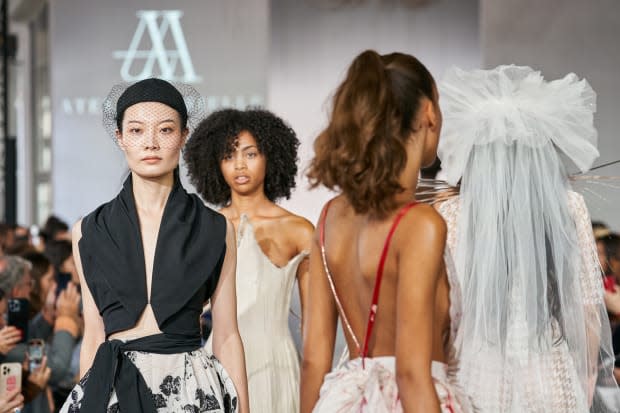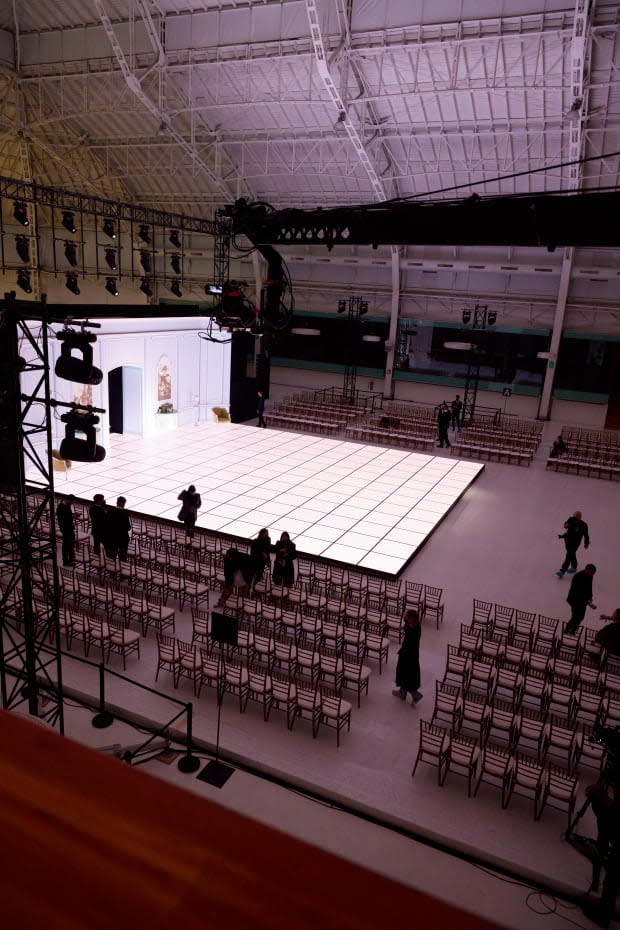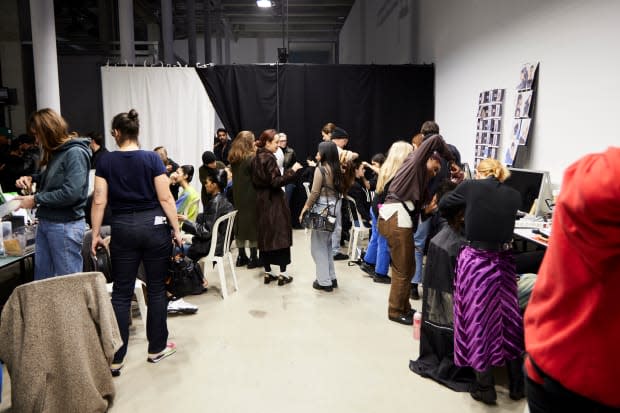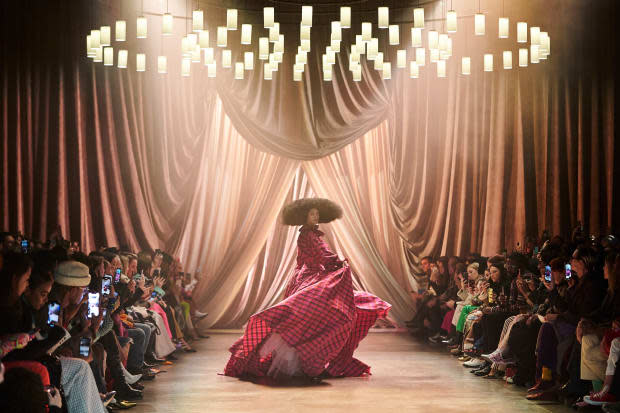Here's Everything That Happens After a Fashion Show Ends
It isn't over once the models do their final walk.
There's nothing quite like a fashion show. From the elaborate sets to the star-studded front row to the clothes, there's an indescribable feeling of adrenaline that overtakes the room: There you are, surrounded by fashion magic, in awe of how all of this came together, if only for 10 to 15 minutes. But once the models have done their final walk, the photographers have taken their last shots, the guests have picked up and gone to the next — what happens, exactly?
From production teams to designers to publicists, there are so many people that play a part in putting a fashion show together. But there's more to the story in its immediate aftermath. Amid the post-show high, social media buzz and much-needed massage bookings, a lot of work still needs to be done. This is fashion, after all — the grind never stops.
Immediately after the show
A fashion show takes months of advance planning, with the breakdown process tied into the grand scheme of things. The post-show to-do list kicks in immediately after the designer takes their final bow — or, in the case of the production team(s), while the show is still happening.
"We've got a pretty unique situation over here at Spring Studios, which is our central footprint for NYFW: The Shows," says Georgie Versi, executive director of fashion events and development director of NYFW: The Shows, the official program put on by IMG. "We host three shows a day in our main runway venue, then we host another two shows a day at Runway X presented by Afterpay — so, we've got five shows happening on any given day."
According to Versi, the IMG production team has a "well-oiled" system that makes sure their events run "kind of like clockwork." That includes resetting the backstage area while a show is happening, so that the space is ready for the next designer coming in, so that they can "begin their hair, makeup and preparation."

Photo: Imaxtree
It's a quick transition once the show wraps up for the designer as well, naturally.
Alejandra Alonso Rojas is usually out of the venue within the hour. "First, [we ensure] we get everything back," she tells Fashionista. "All the garments [are put] back in order, the accessories [are put] back to [into] their boxes... Then we have to take the [whole] collection back to the showroom, because we usually start market the next morning. We have to bring everything from boards to garment racks to boxes back to the studio."
Versi's team will also clear out the whole venue at the end of the week. "After the last show happens, we have a quick toast and say congratulations to the team on a really successful week — then we really dive in," Versi says. "[First we tackle] the smaller things: the racks, the mannequins, the hair and makeup setups, things that are easier to pack up."

Photo: Imaxtree
Meanwhile, on the PR side, a whole new type of work begins.
"Once the show wraps, everybody is drinking champagne and putting their feet up, but we head back to the office because we have to start clipping," says Tenique Bernard, founder of Tenique Bernard Consulting, referring to the practice of capturing all the press coverage for the event that just took place.
While clipping is not nearly as stressful an undertaking as putting on the show itself, Bernard assures that it's equally as thought-out as the planning process. She's carried on many practices from her past jobs — especially her time working at Ralph Lauren — into her own business.
"We used to have a very robust process to report on the coverage for the show — I still do that, even though I work with smaller brands, younger American designers or even emerging designers," she says.
Day(s) after the show
There's always a timeline post-event. How far that timeline spans depends on your role in it.
For Versi, everything is pretty much finished a couple of days after the show. "We have 34 trucks that have to come in over the course of the next two days," she says. "[There are] several hundred lighting fixtures, thousands and thousands of feet of cable(s). We've got four major partner activations on-site and two different show spaces, but only one loading dock at this venue, so everything has to fit together within a puzzle. Scenic is really the first thing that will happen, then lighting and audio. We'll spend the day pulling out all of the lighting fixtures and the speakers, then we'll be done."

Photo: Imaxtree
Outside looking in, runways are applauded for their glitz, glamor and spectacle. But as every industry insider will tell you, fashion is a business, and the decision to put on a fashion show doesn't come from a spur-of-the-moment desire: It's an investment, and the risk must be the worth reward.
Launchmetrics measures the success of a fashion show by calculating "media impact value," which is a dollar amount that reflects "the impact of all of your post interactions, articles across print, online, and social media," says Alison Bringé, the company's chief marketing officer. "I need to be able to understand what all of those activities are worth and also, 'Okay, I spent, I don't know, a million dollars on the show, I had 1,500 people come — what was the ROI on those activities?'"
The peak period that Launchmetrics looks at to measure media impact value happens much quicker than you would think: According to Bringe, "we've found through our data the optimal time is really about three days after the show." That usually covers "80% of what we call amplification — that means the articles and the images being posted and going viral about your show."
During this time frame, another important business matter needs to be handled: selling the collection.
In the midst of fashion month, buyers, merchandisers and retail fashion directors are selecting which pieces just unveiled on the runway they want be sold in their stores in the coming months and placing orders (a process referred to simply as "market").
"The fashion shows and market happen [almost] simultaneously," says George Fountas, vice president and general merchandise manager at Bergdorf Goodman. "Sometimes, it can be the next day or just a few days after — it really depends on the brand and how ready they are... But it's totally overlapping. [We're] making the buying decisions pretty soon after we see the runway."
What Fountas is looking for within a collection varies, especially since "there's not one Bergdorf Goodman customer," as he puts it: "You have to put on different customer hats in different situations."
"More than anything, it's more of a feeling than a look," he says. "Obviously, your eyes take it in, then you have that emotional reaction. But that's what we look for: what's hitting us in our gut, like, 'Oh my God, that's dropped-dead gorgeous,' or like, 'That's so amazing, I've never seen that before.' A lot of it is head and heart."

Photo: Imaxtree
Of course, market is also an opportunity for designers to gauge what retailers are looking for.
"I personally really love the feedback," says Rojas. "I usually have my sales director run the appointment, but I always like to introduce myself [and] get a sense of where the store's located, what's their vibe, who's their client. That's very useful for me to design... I feel like we all have a taste and I [design] with all of my passion, but I can take it [in] if someone likes one dress better than the other."
Weeks after the show
As quickly as the fashion show came, a few weeks later, nearly everything is done.
"Fashion show-specific work is probably wrapped within like two weeks," Bernard says. "The press has moved on from specific show coverage to trend coverage."
Since the pandemic, the fashion calendars don't operate with the same clarity they used to, causing overlap between seasons — some brands are showing "traditionally" (i.e. for the following season), others are showing in-season.
Fountas "will have written all of our orders by mid-March" from the Fall 2023 shows, he says. "There might be a couple of stragglers, and then we'll start to move into pre-spring, resort, cruise deliveries, which then go into the following spring... Spring runways aren't done until October, so these are long buying cycles."
Rojas takes her collection to Paris for market only a couple weeks after her show, but otherwise, she's already begun conceptualizing the next few seasons. Having just debuted Fall 2023, she's already onto Resort (typically unveiled in the summer) and Spring 2024.
"I work on resort and spring together, then we just divide it — I don't work in four separate seasons,' Rojas says. "I conceptualize everything in chunks of two. [That] really allows me to spend time with the [line] and not be rushing from one collection to the other."
In other words, it isn't long before the entire industry is onto the next.
Never miss the latest fashion industry news. Sign up for the Fashionista daily newsletter.
